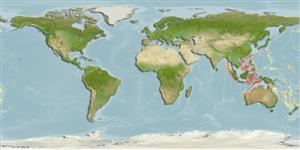Classification / Names
Common names | Synonyms | Catalog of Fishes(genus, species) | ITIS | CoL | WoRMS | Cloffa
Teleostei (teleosts) >
Pleuronectiformes (Flatfishes) >
Cynoglossidae (Tonguefishes) > Symphurinae
Etymology: Symphurus: Greek, syn, symphysis = grown together + Greek, oura = tail (Ref. 45335).
Eponymy: Dr James Wood-Mason (1846–1893) was a British zoologist, lepidopterist and specialist in marine animals and made the first collection of molluscs from the Andaman and Nicobar Islands (1872). [...] (Ref. 128868), visit book page.
More on author: Alcock.
Environment: milieu / climate zone / depth range / distribution range
Ecology
Marine; bathydemersal; depth range 247 - 1046 m (Ref. 26165). Deep-water
Eastern Indian Ocean: Andaman Islands. Reported from the Philippines (Ref. 11790).
Size / Weight / Age
Maturity: Lm ? range ? - ? cm
Max length : 13.6 cm SL male/unsexed; (Ref. 26165)
Life cycle and mating behavior
Maturity | Reproduction | Spawning | Eggs | Fecundity | Larvae
Alcock, A.W., 1889. Natural history notes from H.M.'s Indian marine survey streamer 'Investigator, '... - No. 10. List of the Pleuronectidae obtained in the Bay of Bengal in 1888 and 1889, with descriptions of new and rare species. J. Asiat. Soc. Bengal 58(pt. 2, no. 3):279-295. (Ref. 11854)
IUCN Red List Status (Ref. 130435: Version 2024-2)
Threat to humans
Harmless
Human uses
Tools
Special reports
Download XML
Internet sources
Estimates based on models
Preferred temperature (Ref.
123201): 6.7 - 11.5, mean 8.8 °C (based on 446 cells).
Phylogenetic diversity index (Ref.
82804): PD
50 = 0.5000 [Uniqueness, from 0.5 = low to 2.0 = high].
Bayesian length-weight: a=0.01000 (0.00244 - 0.04107), b=3.04 (2.81 - 3.27), in cm total length, based on all LWR estimates for this body shape (Ref.
93245).
Trophic level (Ref.
69278): 3.3 ±0.4 se; based on size and trophs of closest relatives
Resilience (Ref.
120179): Medium, minimum population doubling time 1.4 - 4.4 years (Assuming tmax>3).
Fishing Vulnerability (Ref.
59153): Low vulnerability (10 of 100).
